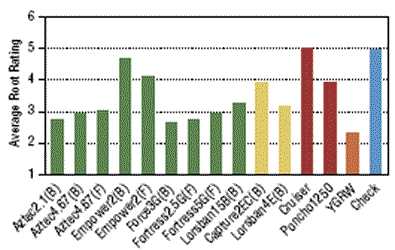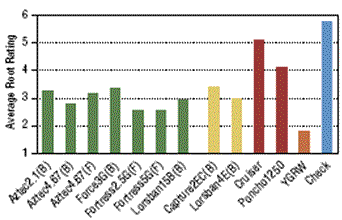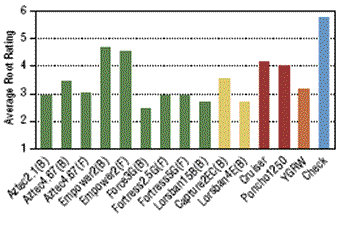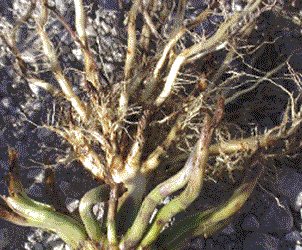Corn Rootworms Presented Significant Challenges in 2004: Product Performance Issues Linger
 |
Michael E. GrayProfessor and Extension Specialist in EntomologyPhone: (217) 333-6652 E-mail: megray@illinois.edu |
||
In 2004, corn rootworms inflicted considerable larval damage to many cornfields across the state of Illinois. Severe lodging was reported in continuous corn as well as rotated corn. In many instances, lodging occurred despite the use of soil insecticides, insecticidal seed treatments, or the use of transgenic insecticidal hybrids (YieldGard Rootworm) for corn rootworms. Spring weather and soil conditions were conducive to early tillage and planting. Consequently, many farmers were finished with corn planting well before the end of April. Soil conditions were ideal (warm and well–drained) at the time of corn rootworm larval hatch, enhancing survival, and the population of corn rootworms flourished.
On–Farm Survey of First-Year Corn Rootworm Larval Injury
During late July and early August, an on–farm survey of western corn rootworm larval injury was conducted in 24 Illinois counties. In each county, 10 first-year cornfields were selected at random and five roots were evaluated for injury on the Iowa State 1–to–6 injury scale.
The established economic injury index for this scale is considered to be equal to a rating of 3.0 (some roots pruned, never equivalent to 1 node of roots). Counties included in the 2004 survey were those located primarily in northwestern and western Illinois (Figure 1). In addition, a few counties such as Clay and Fayette were included to track the movement of the variant western corn rootworm to the south. The percentage of roots within a given county that equaled or exceeded an injury rating of 3.0 was significant for several counties, including Bureau (30%) and Stark (72%). These results indicate the variant western corn rootworm continues to expand its range in Illinois. For a more complete discussion of the survey results, please consult the following web site: http://www.ipm.illinois.edu/bulletin/article.php?issueNumber=23&issueYear=2004&articleNumber=3.
Corn Rootworm Product Efficacy Trials
In 2004, we established corn rootworm product efficacy plots in our three standard experiments in trap crop settings. Planting dates for DeKalb, Monmouth, and Urbana were 28 April, 27 April, and 19 April. These planting dates are considerably earlier compared with the previous year by 1 month, 19 days, and 24 days, respectively. The corn rootworm larval hatch in central Illinois was estimated to be about 1 week to 10 days earlier than that in 2003. In 2004, we planted a Golden Harvest (H-8588 RW) YieldGard corn rootworm hybrid and its isoline (Golden Harvest H–8799). Root injury (1 to 6 scale) in the check was severe at each location and averaged 5.0 (2 nodes destroyed), 5.75 (2� nodes destroyed), and 5.8 (nearly 3 nodes destroyed) at DeKalb, Monmouth, and Urbana, respectively (Figures 2, 3, and 4). Root evaluations were conducted for each of these locations on 21 July, 15 July, and 10 July, respectively. Root injury ratings for the Golden Harvest YieldGard corn rootworm hybrid for DeKalb, Monmouth, and Urbana were 2.35, 1.80, and 3.15 (pruning occurred, considerably less than 1 node). The level of root injury at the Urbana experiment was greater than anticipated; however, not alarmingly high. Transgenic plants from our DeKalb, Monmounth, and Urbana trials were checked (by Monsanto) for expression and the results were positive.
In several ways, the results from our rootworm control trials in 2004 substantiated most of the generalities about rootworm control that we have stated in the past. In general, when accurately applied and incorporated, granular insecticides provide better protection against corn rootworm larvae than liquid insecticides and seed treatments. The exception to this statement is Empower 2, which does not seem to be a very effective rootworm control product. It is also worth noting that Lorsban 4E, under the conditions of our trials in 2004, performed relatively consistently (mean root ratings of 2.65, 3.15, and 2.65 at Urbana, DeKalb, and Monmouth, respectively).
The insecticidal seed treatments currently on the market do not protect corn roots from corn rootworm larval damage very well when infestations of corn rootworm larvae are heavy. We have stated this before, based upon the results from our trials during the past few years, and the results from our trials in 2004 validate the statement. Producers should consider using another rootworm control tactic in fields with a high risk of severe rootworm damage. For a more complete discussion of our insecticide efficacy trials for 2004, please consult the following web site: http://www.ipm.illinois.edu/bulletin/article.php?issueNumber=22&issueYear=2004&articleNumber=2
A caveat about our rootworm control trials is in order. Many corn producers ask, "Why did product X work in your trials, but it didn't work for me?" Our three rootworm control trials provide only three snapshots of product efficacy each year; however, rootworm control products are used on millions of corn acres in Illinois each year. Because many factors (e.g., environmental conditions, lack of incorporation) affect the efficacy of rootworm control products and because soil and environmental conditions can differ significantly from one location to another, the results from our trials will not reflect the results that might be obtained under different conditions. Therefore, the only way to assess the reliability (or lack thereof) of a corn rootworm control product is to assess the consistency of a product's performance over time and geography. Producers should review efficacy data from several objective sources, including results from other land-grant universities and from independent consultants. Also, producers should consider asking other producers about their experiences with corn rootworm control products. Products that perform consistently well in universities' and consultants' trials and in other producers' fields are the products that will be reliable under most circumstances. That having been said, however, no corn rootworm control product is "bulletproof," and certain circumstances can challenge even the most consistent product. For example, past research has shown that inadequate incorporation can reduce the effectiveness of some granular products. Consequently, we emphasize that all corn rootworm control products should be applied or planted with rigorous attention to label directions (e.g., placement, incorporation) to ensure that the product has the optimum likelihood for providing an acceptable level of root protection.
YieldGard Rootworm Performance Issues
During 2004, some producers completed just their first or second growing season with YieldGard Rootworm hybrids (MON 863, Cry3Bb1, Vector ZMIR 13L). As with any new technology, there is much to learn about this new management approach for corn rootworms. Indeed, this past growing season yielded surprises with a YieldGard Rootworm hybrid in one of our experiments. In the first issue (March 20) of the 2003 Pest Management and Crop Development Bulletin, we alerted producers who intended to plant YieldGard Rootworm hybrids that they should anticipate finding adult corn rootworms in their YieldGard Rootworm cornfields. These adults included immigrants as well as those emerging directly from YieldGard Rootworm fields. Unlike Bt hybrids (MON 810, high-dose event) deployed against European corn borers (in which survivorship of corn borer larvae is rare), the use of transgenic hybrids (MON 863, Cry3Bb1) for corn rootworm larvae results in plentiful adult emergence. The EPA has characterized the MON 863 event as a non–high dose event.
On 13 July, a severe storm swept across central, north central, and east central Illinois counties. High winds and torrential rains characterized this impressive storm. Within a few days, we began to receive telephone calls and e-mail inquiries concerning severely lodged corn, including concerns from some producers who had planted YieldGard Rootworm hybrids. Field visits were conducted in some of these producers' fields. Sometimes, root injury was greater than expected. In other fields, the level of root pruning was minimal in the YieldGard Rootworm fields. Yet, the fields were severely lodged and harvestability was compromised.
In late July, we began to notice lodging of corn plants in our Urbana trial, including those in the YieldGard Rootworm treatment. During the first week of August, we rated (1 to 6 scale) 40 roots (10 per replicate) for injury from the YieldGard Rootworm treatment. Slightly more than 3 weeks had elapsed since our original ratings were taken on 10 July. Root rating (1 to 6 scale) averages per replicate were 3.6, 3.4, 3.6, and 3.8 (overall average 3.6). The range in root injury was 3 to 4 (60% of the roots were rated 4.0, Figure 5). Not a single root rating of 1 or 2 was observed during the root evaluations in August. To more precisely quantify the level of pruning on these roots, we also rated them on the 0 to 3 rating scale. Root injury ratings per replicate were 1.43 (nearly 1½ nodes destroyed), 1.08 (1 node destroyed), 1.64 (slightly more than 1½ nodes destroyed), and 1.24 (slightly more than 1 node destroyed). The overall root rating (0 to 3 scale) was 1.35 (1 1/3 node destroyed). This level of injury was much greater than we observed in July. We continue to seek a satisfactory explanation for these observations. Compromised root protection may be the result of several complex interactions involving, but not limited too: early planting, poor expression of the Bt protein in the chosen hybrid, diminished expression of the Bt protein as the season progressed, intense rootworm larval densities, and other poorly understood environmental (soil moisture, temperature) and agronomic (nitrogen level) variables. We do not believe corn rootworms have developed resistance to this new technology during only its second year on the market. For a more complete discussion of this topic, please consult the following website: http://www.ipm.illinois.edu/bulletin/article.php?issueNumber=22&issueYear=2004&articleNumber=1.
We still have much to learn about transgenic insecticidal cultivars and their role in an overall corn rootworm management program. One thing seems certain, there continues to be no silver bullet that can be directed at this impressive and resilient insect pest of corn. A final point needs to be made. To date, albeit a short history, transgenic insecticidal corn rootworm hybrids (MON 863, Cry3Bb1) have proven very consistent in their ability to limit corn rootworm larval injury. Despite the "stumble" of certain YieldGard Rootworm hybrids in some locations in 2004, producers should not automatically assume that granular soil insecticides delivered at–planting will deliver more consistent root protection. They too are subject to many environmental variables that may affect their performance.
Portions of this paper were extracted directly from articles written previously by Michael E. Gray and Kevin L. Steffey and published in the Pest Management and Crop Development Bulletin and the 2005 Crop Protection Technology Conference Proceedings.
Tables & Figures
 |
Figure 1. Percentage
of corn roots from first–year cornfields that exceeded a root injury rating of 3.0 (Iowa State 1 to 6 scale). |
 |
Root injury ratings for DeKalb,
Illinois, 2004. Planting date: April 28. Rainfall: May, 9.5"; June, 3.1"; July, 2.1"; August, 3.3". |
 |
Root injury ratings for Monmouth, Illinois,
2004. Planting date: April 27. Rainfall: May, 4.0"; June, 2.4"; July, 5.7"; August, 5.8". |
 |
Figure 4.Root injury ratings for Urbana, Illinois
2004. Planting date: April 19. Rainfall: May, 4.4"; June, 3.8"; July, 5.7"; August, 3.6". |
 |
Figure 5. YieldGard Rootworm root system with
severe pruning, Urbana, Illinois, 2004. |